After Halloween, limit your child’s candy stash and encourage moderation to protect their teeth from cavities and erosion. Opt for non-sticky, quick-melting candies like chocolate, and avoid sour or gummy treats that stick or contain acids. Teach your child good brushing and flossing habits, and consider healthy alternatives like fruit or sugar-free gum. If you want to learn how to make Halloween treats safer for teeth and protect your child’s smile, keep going for expert tips.
Key Takeaways
- Limiting candy intake and choosing non-sticky, quick-melting chocolates can reduce cavity risk for children.
- Encourage good oral hygiene practices, including brushing twice daily and flossing after candy consumption.
- Opt for healthier snacks like fruits and vegetables instead of sugary candies to protect teeth.
- Teach kids moderation and routines to discard or trade excess candy within days.
- Schedule dental checkups promptly if children experience tooth sensitivity, pain, or visible signs of decay.
The Impact of Candy Bingeing on Dental Health

While a single night of candy bingeing usually won’t cause cavities, it’s the repeated and prolonged consumption of sugary treats that really harms your child’s dental health. Over time, long-term exposure to sugar fuels bacteria that produce acids, leading to tooth decay. Additionally, sticky candies like caramel and gummies stay on teeth longer, increasing the risk of cavities because they’re harder to clean away. Sour candies contain acids that can erode enamel if eaten excessively. The key to protecting your child’s health is moderation and good oral hygiene. Limiting candy intake after Halloween and encouraging regular brushing help minimize the risk of long-term damage. Understanding the effects of dental solutions can remind us of the importance of managing exposure to various hazards, including dietary ones. Advances in machine learning are also being used to develop smarter dental diagnostics and personalized treatment plans, improving overall dental health outcomes. Moreover, implementing preventive measures in dental care can further reduce the risk of cavities caused by dietary habits.
Choosing the Right Candies for Your Child’s Teeth
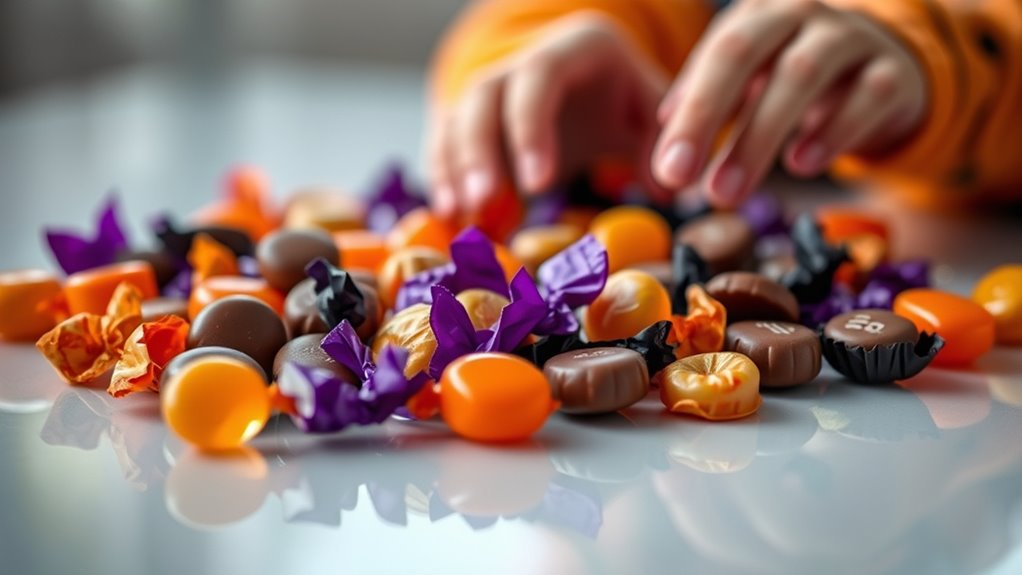
To protect your child’s teeth, consider choosing candies that are less likely to cause cavities. Opt for sugar-free options whenever possible, as they reduce acid production in the mouth. Additionally, avoid sticky candies like gummies and caramel that cling to teeth and stay there longer. Incorporating oral health practices into your child’s routine can further help maintain oral health and prevent dental issues.
Opt for Sugar-Free Options
Choosing sugar-free candies is a smart way to protect your child’s teeth during Halloween. These candies, especially those with the ADA Seal of Acceptance, help reduce the risk of tooth decay.
Many sugar-free options contain xylitol, which can inhibit the growth of cavity-causing bacteria, making them a healthier choice. Necessary cookies are essential for the site to function properly, ensuring a smooth browsing experience.
When you select candies labeled as “sugar-free,” you’re minimizing your child’s exposure to fermentable carbohydrates that feed decay. Oral health benefits include reduced cavity risk and healthier teeth.
Additionally, sugar-free gums and candies stimulate saliva flow, helping to neutralize acids and wash away bacteria that cause cavities. Saliva stimulation is an important factor in maintaining oral health during candy consumption.
Just be sure to check ingredient labels carefully to avoid hidden sugars or acids that could harm teeth. Monitoring your child’s candy intake and choosing wisely can further support their dental health.
Opting for sugar-free candies is a simple step toward maintaining your child’s oral health during Halloween festivities. Storage in airtight containers can help keep candies fresh and prevent contamination.
Choose Non-Sticky Candies
Opting for non-sticky candies like chocolates and hard candies can substantially reduce the risk of tooth decay. Non-sticky treats don’t cling to your child’s teeth as long as chewy, sticky options, making them a smarter choice. Additionally, choosing candies with a moisture control system can help maintain optimal oral health by reducing prolonged sugar contact. Candies that melt quickly, such as chocolates, minimize sugar contact with tooth surfaces and lower cavity risk. Avoid gummy and caramel candies, which prolong sugar exposure and increase decay chances. Be cautious with sour candies, as their acids can erode enamel, causing further damage. Incorporating oral health considerations into candy choices can further protect your child’s teeth during Halloween and beyond. Selecting candies that are less acidic can help prevent enamel erosion and maintain healthier teeth. Choosing non-sticky, easy-melting candies helps prevent plaque buildup and reduces the need for extensive brushing afterward. Being aware of tuning modifications can help you choose healthier candies that support your child’s dental health.
How Candy Type Affects Cavity Risk
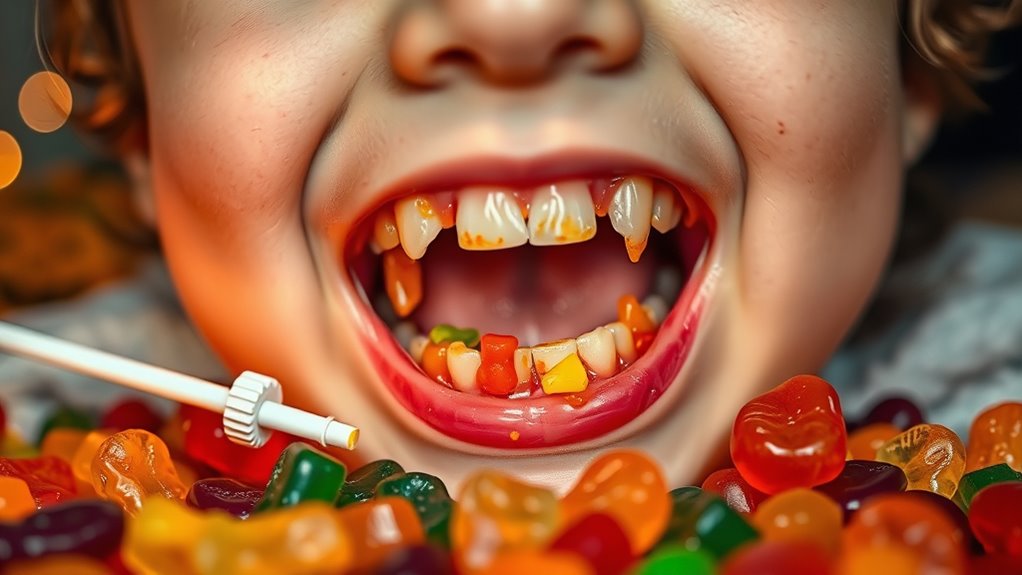
The type of candy your child eats can markedly impact their cavity risk. Sticky candies like caramel and gummies cling to teeth longer, increasing decay chances.
While chocolate melts quickly, reducing sugar contact, sour candies contain acids that can erode enamel, making teeth more vulnerable.
Sticky Candies Stay Longer
Sticky candies like caramel, taffy, and gummies cling to your child’s teeth, making them difficult to remove with brushing. Because they stay in the mouth longer, these candies give acids more time to demineralize tooth enamel, increasing the risk of cavities.
Their prolonged contact with teeth heightens the chance of dental problems compared to candies that melt quickly. Sticky candies also contain high sugar levels, which feed bacteria in the mouth and produce more cavity-causing acids.
This combination of prolonged exposure and sugar content poses a significant threat to your child’s dental health. To protect their teeth, limit the consumption of sticky candies, encourage thorough brushing, and remind your child to floss after treats.
Recognizing how sticky candies stay longer can help you make smarter choices during Halloween.
Chocolate Melts Quickly
Since chocolate melts quickly in the mouth, it reduces the amount of time sugars and acids stay in contact with your child’s teeth. This rapid melting means less opportunity for cavity-causing bacteria to feed on sugars and produce acids that damage enamel. Additionally, because the contact time is shorter, the risk of acid erosion is minimized. Salivary flow, which helps neutralize acids, can also be more effective when sugars are quickly cleared from the mouth. Oral health benefits of choosing chocolate over sticky or sour candies during Halloween include fewer cavities because it dissolves faster. Dark chocolate, in particular, contains less sugar than milk chocolate, further decreasing cavity risk. The quick melting process minimizes the duration that acids and sugars linger on tooth surfaces, offering added protection. E-commerce technology advancements have made it easier for consumers to access a variety of healthier options for treats. Incorporating wireless technology can help parents monitor and manage their children’s candy intake more effectively during festivities. Choosing chocolate over sticky or sour candies during Halloween is a smarter move for your child’s dental health. By opting for chocolate, you’re helping reduce the likelihood of cavities while still enjoying the treats of the holiday.
Managing Post-Halloween Candy Stash

After Halloween, managing your child’s candy stash is key to protecting their dental health. Limiting the amount of Halloween candy they keep reduces chances of frequent snacking on sugary treats, which can harm their child’s teeth.
Encourage your child to pick a few favorite candies for immediate enjoyment and save the rest for special occasions.
Donating leftover Halloween candy to charities like Operation Gratitude helps prevent excessive consumption and promotes community kindness.
Keep unused candy out of reach or stored in sealed containers to minimize temptation and spontaneous snacking.
Establish a routine to discard or trade away excess candy within a few days after Halloween. This strategy helps control their intake, reduces prolonged exposure to cavity-causing sugars, and supports better oral health overall.
Incorporating preventive dental measures, such as brushing and flossing regularly, can further enhance your child’s oral health and reduce the risk of cavities caused by Halloween treats. Being aware of dental health and how it can be compromised by sugar intake encourages better habits and helps maintain healthy teeth. Additionally, understanding how glycolic acid benefits can improve skin radiance highlights the importance of overall health and self-care routines.
Tips for Talking to Kids About Candy Consumption

Talking to your kids about candy consumption helps them make smarter choices and protect their teeth. Explain that enjoying candy in moderation is key to keeping their mouth healthy for a long time.
Encourage them to pick a few favorite candies and set aside the rest to avoid overeating.
Choose a few favorite candies and save the rest to prevent overindulging.
Teach them that eating candy after meals boosts saliva flow, which naturally fights cavities. Saliva not only helps wash away food particles but also contains minerals that strengthen tooth enamel.
Be sure to mention that sticky and sour candies tend to stay on teeth longer and can cause more damage, so they should be enjoyed sparingly. Understanding dental health fundamentals can help children appreciate why good habits matter.
Remind your kids that brushing their teeth before bed after Halloween treats is essential for a healthy smile.
For variety and better oral health, consider offering gelato or frozen yogurt as a sweet alternative to traditional candy.
Understanding that sound vibrations can influence cellular regeneration and overall health highlights the importance of moderation in treats, making it a good lesson for kids about balance in their diet.
Additionally, explaining how natural saliva helps protect teeth can reinforce the importance of good oral hygiene habits.
Best Practices for Oral Hygiene During Halloween Season
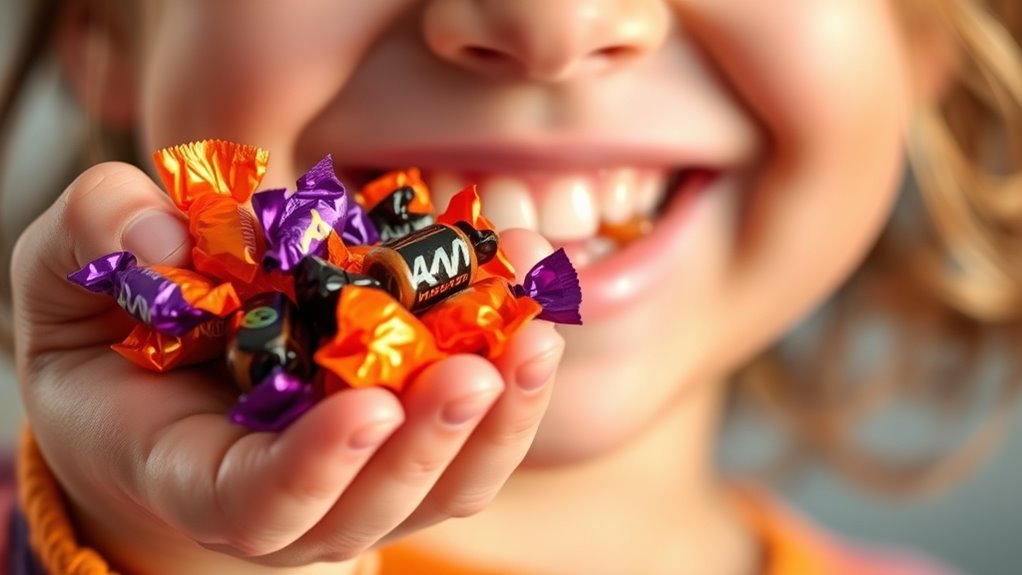
During Halloween season, maintaining good oral hygiene is essential to prevent cavities and enamel damage from increased candy consumption. To do this effectively, follow these best practices:
- Brush twice daily with fluoride toothpaste, especially before bed, to remove residual sugars and plaque.
- Floss daily to eliminate candy particles stuck between teeth, reducing cavity risk.
- Encourage your child to rinse their mouth with water after eating sweets to neutralize acids and wash away sugars.
- Schedule regular dental visits starting by age one, and see the dentist every six months for early detection and prevention.
- Understanding how sugar impacts your child’s teeth can help motivate better dietary choices during the holiday season. Recognizing the importance of dental health maintenance emphasizes the need for consistent oral care routines.
Healthy Alternatives to Candy and Sugary Treats
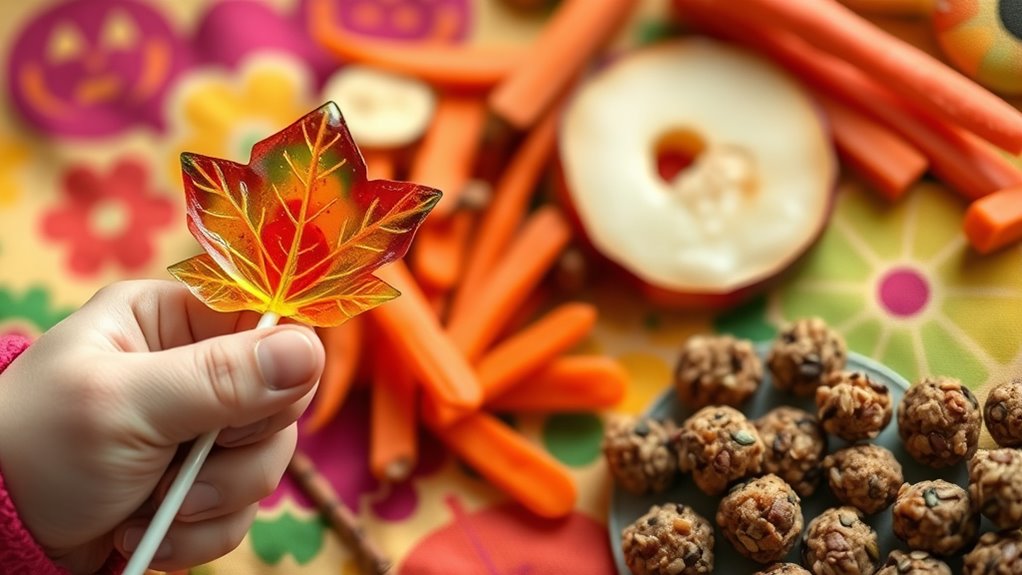
Choosing healthy alternatives to candy and sugary treats can make Halloween both fun and tooth-friendly. Instead of sugary options, consider offering fresh fruits like apple slices, berries, or orange segments. These provide natural sweetness and essential vitamins without promoting tooth decay.
Crunchy vegetables such as carrots and celery help clean teeth surfaces and stimulate saliva production, which neutralizes acids. Nuts and seeds are also excellent low-sugar, nutrient-dense snacks that satisfy cravings and promote dental health.
Sugar-free gum or mints with the ADA Seal of Acceptance can be a fun, cavity-preventing treat, especially when chewed after snacks.
Additionally, non-candy treats like stickers, coloring books, or small toys encourage fun without adding sugar or risking dental issues.
These healthy alternatives make Halloween enjoyable and safe for your child’s teeth.
When to Seek Professional Dental Advice

After exploring healthy alternatives to candy, it’s important to know when your child’s dental health might need professional advice. Keep an eye out if your child:
- Experiences tooth sensitivity or persistent pain after Halloween treats.
- Shows visible damage like chips or cracks in their teeth.
- Develops cavities or signs of enamel erosion.
- Has ongoing discomfort or unusual changes in their dental health.
While dark chocolate is a better option than many candies, it’s still important to seek professional guidance if issues arise.
Regular dental visits within six months of Halloween help catch early decay caused by sugary treats. If you notice any of these signs, consult a dentist promptly to protect your child’s smile and ensure their dental health stays on track.
Creating a Balanced Approach to Halloween Celebrations
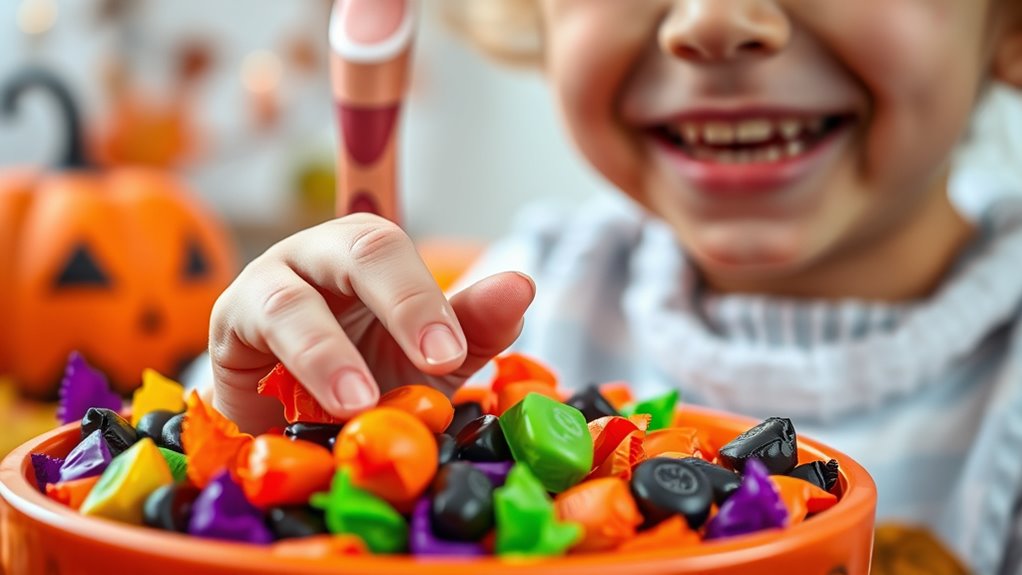
Finding a balance between enjoying Halloween treats and maintaining good dental health is key to a fun and safe celebration. You can allow your child to indulge in a few candies after meals, helping to reduce cavity risk. Choosing chocolates over sticky or sour candies minimizes prolonged sugar contact and enamel erosion. Setting limits on leftover candy and encouraging trades or donations prevent constant snacking. Incorporating fun non-candy items like stickers or toys keeps the celebration lively while supporting oral health.
Imagine this scene:
| Candy Type | Frequency of Treats | Alternative Rewards |
|---|---|---|
| Chocolate bars | Once after dinner | Stickers |
| Sticky caramels | Rarely | Small toys |
| Sour candies | Occasionally | Extra playtime |
| Leftover candies | Limited, traded | Books or crafts |
Frequently Asked Questions
Should You Let Your Kids Eat Halloween Candy?
You wonder if you should let your kids eat Halloween candy. It’s okay to allow treats, but moderation is key. Limit their intake to one or two pieces daily, preferably with meals, to reduce cavity risk.
Encourage them to brush afterward and choose less sticky, sour candies. Don’t forget to donate or discard excess sweets.
What Do Dentists Do With Halloween Candy?
Think of what dentists do with Halloween candy as turning a mountain into a molehill. They often participate in candy buy-back programs, swapping sweets for cash or gifts, which encourages moderation.
Some donate the leftovers to organizations like troops overseas or recycle the candy.
Others use it to teach kids about dental health, hosting fun events or giving non-candy prizes. This way, they turn a sugary challenge into a positive opportunity.
Where Can I Donate Extra Halloween Candy Near Me?
You can find places to donate your extra Halloween candy by searching online for local charities or events. Check with your community centers, food banks, or schools—they often host candy drives.
Some dental offices also organize collection events, promoting dental health awareness. Additionally, organizations like Operation Gratitude accept candy donations for troops and first responders.
What Is the Most Unhealthy Candy for Your Teeth?
Did you know that sour candies are twice as damaging to teeth as regular sweets? The most unhealthy candies for your teeth are those that are sticky, sour, or hard.
Sticky candies cling to teeth longer, increasing cavity risk. Sour candies contain acids that erode enamel, and hard candies can cause fractures if bitten.
For better dental health, limit these types and encourage your child to enjoy sweets in moderation.
Conclusion
As you navigate the sweet festivities, remember that moderation and mindful choices can gently guide your child toward healthier habits. Embracing a balanced approach allows the joy of Halloween to shine without overshadowing their radiant smile. With thoughtful conversations and diligent care, you create a nurturing environment where treats become moments of delight rather than delicate balances on the edge. Ultimately, your guidance helps foster both happiness and lasting dental well-being.









